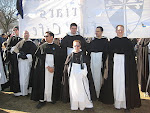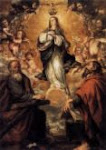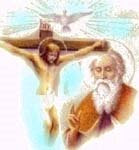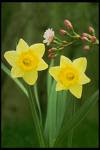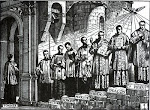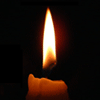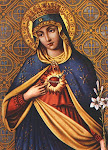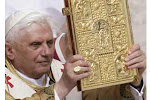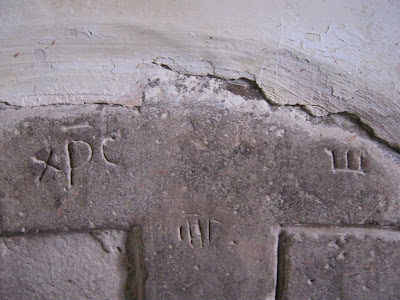POSTCODE
HR2 ONY
Brychan Brycheiniog, the famous king of Irish ancestry, married into the community of Garth Madrun or Talgarth, where a number of settlers had lived for some centuries, granted land by Cunebelinus. Brychan’s children and grand children were famed saints of Wales and Cornwall, who were of the line of Brychan Brycheiniog, his line being one of the ‘Three Holiest in Wales’.
St Cladawg-eldest son.
St CLYDAWG-FEAST DAY November 3
< This picture of a statue in Cil Pedic's Church (Kilpeck) could be (British tonsure) St Clydawg, except he is not depicted with a crown-but does have a martyr's palm. It may also ,of course be St Pedic.Whether in statues of this period a crown may have been shown is another matter>
ECCLESIA DE SANCTO CLADOCO
(In the Welsh Primers of 1546, 1618, 1633, Cotton Manuscripts , Welsh Almanacks . Alwydd Paradwys gives the date as August 19. Also other sources favour this date.)
The story of St Clydog was first written down from the oral tradition of the Bards in the twelfth century in the Book of Llandaf. His life story is also told by John of Tynemouth in the thirteenth century, which was a transcript of the Liber.
Clydog was the son of Clydwyn, who was a son of Brychan. Clydwyn was himself a saint from the
Cognatio de Brychan. It is stated that he ‘invaded the whole of South Wales or ‘conquered Deheubarth,’ and that he was the father of Clydog and Dedyw and both of them ruled here. There was also a daughter ,St Perdita, that has been ascribed to him. It is probably not true that he conquered the whole of South Wales. All the genealogical lists make him son of Brychan, but also that he may have been King of Ceredigion and Dyfed Clydwyn also had a daughter, aside from his two sons, named Gwledyr. He shares a feast day with his father St Clydwyn. A place called ‘
Cruc Cletwyn’ (his mound’) is mentioned in the Talley Abbey Charter of 1331.Hid aunt was St Clydai the Virgin. Was married three times to Prawst(1), Ribrawst(2) and Roistri (3) and his other brothers were Arthen,Papay,St Cynon (of Abercynon near Penrhys),Dingat (of Llandingat (Dingestow),Pasgen, St Cynlefr the Martyr,(Merthyr Gynlefr), St Berwen (llan in Cornwall)Cydoc or Iddog (Llan in Britanny-Ton Ridoch)The Sepulchre of Brychan was on the island called Ynys Brychan and is near the Isle of Man. Another source (Cott manuscript) says Brychan had thirteen sons and twenty four daughters!
He was King here in Ewyas (partly in Monmouthshire and partly in Herefordshire-the old Welsh Kingdom of Ergyng) He was one of the king-saints, ruling with justice, peacefully and with holiness.His early formation as a Catholic priest was at Llancarfan under the glorious Saint Cadoc, son of St Woolos(Gwynlliw) of Newport. He and his brother studied theology and philosophy, Latin and Greek there and were ordained. Cadoc himself was a prince. They spent a great deal of time there and worked with him in Cadoc’s own foundations in Monmouthshire and Glamorgan.
On his return to Ewias, acertain woman, the daughter of a nobleman, fell in love with him and would marry no one else. One of Clydog’s nobles, a Saxon, his eye having fallen upon the woman, decided she should be his and no one else’s. The following day whilst the holy and noble King, after having attended the Mass, went out hunting and whilst taking aim at a stag, was shot and killed by his erstwhile friend. The body was placed on a cart and driven towards a river, where there was a ford. This is the bridge area at the stream below the present church, where the water is very shallow. The river Monnow, which also flows through Monmouth, was a barrier and the yoke carrying the cart broke and the oxen would not be driven further. There the great king died and was buried. A great fire was seen to be burning over the grave that night and the Bishop (probably Teilo) ordered that there be built a Martyrum or Martyr’s Chapel over the place of his grave. His sorrowing people, who had loved their wise and saintly king did so. This is Caer Gledog, now in England (Loegr) Probably nearby Longtown was meant by this , where there was an ancient British Camp. (Caer)The Book of Llandaff (Cardiff area) affords proof that Brychan’s rule extended into this area.
There was a further story that two men who had been at loggerheads for a long time vowed upon the tomb of St Clydog to be reconciled. On their way back from the church ,one turned on the other and treacherously murdered him, but immediately afterwards, stricken by a guilty conscience, he fell upon his spear and died miserably.

In Welsh, the scene of St Clydog’s martyrdom, (as a Christian King by an evil traitor) allowed the people to acclaim him a saint, which was granted at Llandaff by the Bishop-possibly St Teilo. )was known as MERTHYR CLYDAWG or Merthyr Clydawg –his Martyrium, a chapel in which the body of a martyred saint is interred by his grieving brother,Dedyw (who ruled after him, and also founded a llan at Llan-detty at Bwlch in Powys. His church is in Ewias where he was killed by pagan Saxons.Following the martyrdom of the Blessed Clydog, the hermits Llibio,(Cleebeeo)Gwrfan (goorvan)and Cynfar (Kunvarr) were the first inhabitants and cultivators of the place after the martyrdom of St Clydawg the Martyr. So famous was he, that a people were named after him, including a eleventh or twelfth century Bishop of Llandaff.
In later times, Clodock was called ‘Hundred’.The notorious Henry VIII
extirped Wales in 1535 and so Clodock was forcibly taken into England. The parish remained as part of the new Anglican See of Llandaff until 1858 when it was taken over by Hereford. However, this always was Welsh Wales as everyone spoke Welsh here until the beginning of the nineteenth century.
St Clydawg’s church, emulating the spirit of ‘mercy’ for fugitives contained a sanctuary ring which a ‘criminal’ could grasp to ask for refuge ,so Clodock church was chartered as a 'place of refuge' for those escaping from their enemies.The door itself could also be secured with an oak bar. The criminal could remain for forty days, and would have to be provided with food by the congregation .After that time, he would have had to ‘abjure the realm’, that is walk directly to the coast and take the first available boat abroad and never come back. Alternatively, he could give himself up for trial, and with luck, after forty days, those investigating the crime may have come to a different conclusion.
The Welsh Border runs alongside the mountain and there was much rivalry between the Border people, hence the strong solid door dating from around the l5th century. The church is full of history, with faded wall paintings, coats of arms and a Decalogue. It has a memorial stone which is thought to date from around AD 750-850, 'To the dear wife of Guinndo, a resident of this place. In fact there are more memorials to local people than images of the saints and angels of God.Much would have been lost in the restorations.

Because Saint Clydawg was a Martyr, many came to pray at his tomb, pilgrims arrived at this remote place on his feast day, November 3rd.Masses would be said over the tomb. However, it is possible the feast day changed in Norman times, or even earlier. The pilgrims’ season is normally from May to October, because summer weather brings more pilgrims as winter weather would make these pilgrimages more difficult, as snow and bad weather often make the areas impassable. The upkeep of a church is very expensive and the Bishop may have introduced a proxy date for the saint for the convenience of the common good of the faithful, with a local feast celebrated on the November date, when the elderly and disabled would not be so cold. This would have been the local bishop’s prerogative.
Alwydd Paradwys was a Catholic source, and the date may have come from an later Martyrology in Rome. It was the miracles which drew the pilgrims, asking for the saint’s help with prayers. People always needed miracles and prolific celebrations may have happened on both dates. There seem to have been many miracles at St Clydawg's before the
reformation ceased.
The Englishman Whytford gives on November 3rd however:
‘In England ye feest of saynte Clitauke a martyr, a kynges son of strayte justyce, a lover of peace, and of pure chastite, and of a stryte and perfyte lyfe ye was cruelly slayne by a fals tratour at whose deth were showed many miracles and at his tombe after many moo’
St Clydog should be represented holding a sword in one hand and a lily in the other and crowned as a prince,in Norman times.
The Twelfth century church had the following boundary from the Book of Llandaff:
Merthyr Clitauc-‘Clodock’ Its boundary is the sone in the Waun Fraith on the cecin,North end of Hetterall (at yr Haul-to the sun) Hills, along it to Rhiw Gwrw, to the stone on the Cecin of the allt, along the Cecin on the edge of the Brec. Black mountain upwards as far as the stones opposite to Nant Trinant , the Turnant , along it, downwards as far as into the Olchon , along it, the Olchon, downwards as far as Ynys Alarun at its top end , to the Maen Tyllog to the crug to the Monnow , across the Monnow to Aber Nant Cwm Cinreith, the nant throught its length as far as the Mynys Ferfun (anglicised later to Money farthing-trans ‘Fersun’s Hill’)along the Mynys Ferfun to the Loch of Fer un, along the mountain to the source of the Hilin, along the Hilin as far as the Monnow. Along the Monnow downwards as far as Aber Ffynon Bist, along Ffynon Bist as far as its source, From its source to the Cecin straight upwards making for the Waun Fraith (Wine vryth)on the Cecin on the Mountain, as far as the stone where the boundary began.'


It was served by The Abbey of John the Baptist at Llanthony, who were its patrons. Its dedication was to St Clodock. In Rome, in the Taxatio of Pope Nicholas where Clydag is referred to in various Latin forms ST CLEODICUS ST CLYDOG ST CLODOCH ST CLADOCUS( as in evidence of 1517). It was valued in the taxation at the enormous sum of £20, so must have been quite a rich church.It is given as being the Diocese of St David. Since the whole area was overrun by Saxons around 600AD it is likely the Saxons, when they became Christianised, improved the church and it was this church which was rebuilt in Norman times and became attached to the nearby Priory of Augustinian Canons in nearby Llanthony.


This was part of the work of the Norman de Lacey family, who built the castle at Longtown on the rruins of the British Caer (Camp). He appointed a secular priest to serve Longtown in the first instance, but after that the Canons at Llanthony, which he founded with Bishop Ervistus, became responsible for serving the church and village, and there would have been a place of accommodation for visiting priests, possibly even in the Church house adjacent to the church, where a more modern house now stands. There may have been, however more ancient Llan buildings available. The Tithes from the church were, therefore given to Llanthony and the canons or black monks were priests here for two hundred years.
 My Visit 5th October 2010
My Visit 5th October 2010
No one could imagine a lovelier setting for the church and it is quite clear this was a wonderful part of Clydawg’s kingdom.The mountains all around looking down on it and a fast flowing stream and holy well on the south bank of the river.A Norman tower looks down and a tri partite structure shows. The chancel area in the front was probably the original Welsh/Saxon site and then the nave and tower added in Norman times. Interestingly there is an arched recess in the chancel.
One splash of colour, a beautiful stained glass window!

When I entered the church, I was, I have to say, that in spite of the awe inspiring scale and height of this church of pilgrimage, it seemed totally devoid of the colour and charm of a Norman Church. Little pictures peeped out like an enchanting cherub over the pulpit and part of an annunciation(oh please let it be restored!), even a coloured fresco of the Blessed Virgin,in the window splay near the pulpit but for me, the building seemed dominated by its dark brown boxed pews , oak choir stalls and an absolutely enormous three decker pulpit and sounding board, which made it ‘feel’ more like a Non conformist chapel, the altar being a simple wooden table. One wonders, as in so many churches, whether the original Norman altar complete with consecration crosses may be interred under the present table dated about 1650, in the height of the Cromwellian period, with Laudian rails and Housel bench, part of the changes ordered by the Anglican Archbishop Laud. The table is surrounded with rails, allowing the Communicants to gather around it. Some of the choir stalls are beautifully carved with flowers and dragons, but the overall effect quite cold with its brown and white.

There was another restoration in the twentieth century and when the Anglican Revd F.G.Llewellyn arrived in 1916, he found the church virtually a ruin and he raised money to repair and restore the fabric of the church, which was vitally important for its survival.

The font is still that of the old Catholic church and dates from 1290, made of hand cut stone,but quite small, standing on a shaft as big as the bowl.
The priest’s door is still there on the South Wall. Known as the ‘monks’ door’it would have been used by them when they said Mass or came in for the daily office. The oak door is oak studded and dates from a much later date. As in Orthodox churches today, there would have been a rood screen or loft (which were torn down during the sixteenth century)and so the priests would have entered the sanctuary (where the Blessed Sacrament was held in the Tabernacle) and they believed this area was holy and only the ordained could enter. Likewise, no sanctuary lights to show Christ present at all times.
The two plinths at the south side of the arch are empty. It is sad to think of the hatred which smashed the statue of the Blessed Virgin Mary, whom the angel so honoured. She is missing, along with a representation , no doubt of St Clydawg the martyr, similar to those in nearby Kilpeck Church.
In 1645 Scots pillaged the valley and stole the communion plate, since the earliest now there was dated to 1695, so must have been made for the seventeenth century restoration. There are three chests made out of a single log in which records were kept. That of St Peter’s in Longtown (now a private house) was probably the place of the third chest’s origin.
The Gallery was built in 1700 to house the village orchestra and choir and is large, with a music stand, seats for musicians and the choir benches are raked so those behind could see. The large scale of the church is obviously due to its pilgrim status in Mediaeval times, and it now looks a very different church from that appreciated by the pilgrims.
The joyful colours of heaven seemed to be gone from the church in the brown and white. I know villagers would have grown up and love their church, but coming from Wales, it looked more like a chapel. It is going to be interesting how the present congregation will refurbish the church to hand on to the next generation. I hope there will be more colour, having seen St Teilo’s wall paintings at St Ffagans in the Welsh Heritage Museum, you can see how beautiful these churches would have been in the fifteenth century. Only my opinion though, as it is clearly a well loved and cared for church.

.









